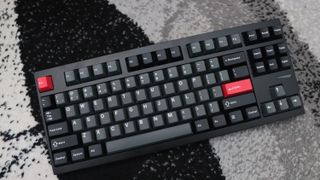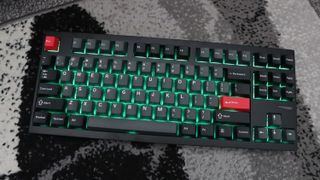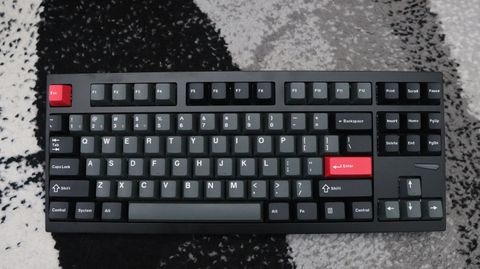Our Verdict
The L4 is the slightly less specced brother to the Keychron Q3 Max, and at the same price, is a bit of an odd recommendation. Make no bones about it, this is a gorgeous keyboard that's packed to the rafters with features, but the Max is better.
For
- Immensely sturdy
- Smooth, lubed switches
- Lightweight software
Against
- Expensive against rivals
- Lack of a knob may be a turn off for some
PC Gamer's got your back
If you haven't heard of Lemokey before, allow me to explain. They are, in essence, an offshoot of Keychron, a keyboard brand we've rated especially highly around these parts in the last few years with models such as the K2 V2 and Q3 Max, who are designed to make more affordable versions of Keychron favourites, as well as their own products.
This new Lemokey L4 continues in the same vein as its half-brothers of sorts in offering a seriously brilliant overall experience, although for a higher price tag than you might expect.
In looking at the L4, it might look quite familiar to the Q3 Max I reviewed earlier this year, just without the crazy side-printed keycaps. It's a seriously hefty TKL layout keyboard that provides the benefit of a functional, space-saving layout and one of the heaviest machined aluminium frames I've handled. For reference, the L4 tips the scales at 1.8 kg, which is heavier than some laptops. With that mass in mind, I wouldn't call it 'portable'.
Usually I describe a keyboard's build quality with their viability as a physical weapon, and the Lemokey L4 is one of the strongest contenders yet, especially with no deck flex and a general feeling of strength. That goes not only for the anodized aluminum frame, but also for its excellent doubleshot PBT keycaps which reiterate the L4's premium feel and suitability for enthusiasts. It looks mean with its black, grey and accented red colourway too, although is also available in blue and white in pre-built form.
Where the L4 differs from the Q3 Max at least in a physical sense is the lack of much in the way of additional extras, such as the customary rotary volume knob I've come to expect from their products. The lack of something to fiddle and twiddle with is a bit of a shame, but you can turn volume up and down with a combination of the Fn key and either F11 or F12 on the function row. There is the customary USB-C port on the back for charging and wired connectivity, as well as a selector switch for either Bluetooth or 2.4 GHz connectivity.

Switch type: Keychron Super Red
Keycaps: PBT, double-shot
Lighting: RGB, dimmable on keyboard and controllable in software
Onboard storage: None
Extra ports: USB-C for charging
Connection type: Wireless - Bluetooth/2.4 GHz receiver
Cable: USB Type-C/USB Type-A, detachable
Weight: 1.8 kg/3.986 lbs
Price: $214
Speaking of connectivity, the L4 worked a charm over either wireless method, connecting with ease to either my MacBook over Bluetooth or my main Windows gaming PC over its USB-A receiver. With both, it was virtually effortless. Pairing over Bluetooth is as easy as holding the function key down with either 1, 2 or 3 on the number row depending on which Bluetooth channel you wish to use until the small blue light underneath the key flashes quickly. The keyboard should then show up in the pairing settings on the device you want to connect to—press 'connect' and you should be off to the races in a matter of moments.
In addition, its battery life is solid too, with up to 240 hours of runtime with no RGB turned on. If you turn the lighting on at its lowest level, this figure drops to 100 hours, although is still respectable for a wireless keyboard. In my time with the L4, I only charged it once at the beginning, and had no need to otherwise.
They say what counts is what's inside rather than out, and the Lemokey L4 is suitably impressive here, too. It features Keychron's 'Super' switches, with either Red, Brown or Banana on offer. My sample shipped with the lightweight and linear Red switches, which were a joy to type on, be it for articles like this or for playing games on after I'd finished working. Being pre-lubricated means they are seriously smooth, while also having a noticeable effect on the L4's acoustics.

Combined with the heaps of sound dampening and foam inside the keyboard's metal chassis, the lubricated switches mean the L4 sounds divine once you get up to speed with a velvety acoustic profile. It is quite loud and high-pitched though, arguably owing to the L4's metal case.
If the switches inside the L4 aren't your jam though, then you can easily swap them out with a range of 3 or 5 pin choices, as this keyboard is hot-swappable. As with Keychron keyboards, the L4 bundles in a switch and keycap puller to make swapping them out a breeze. I had some spare Cherry MX Purple switches left over from my own custom Keychron Q1 Pro which I slotted into the L4, and swapping them in was a doddle, as it usually is with these keyboards.
As is customary with every mechanical keyboard in the known universe from the last however many years, there is that sweet, sweet RGB lighting if you want it. By default, it cycles through a spectrum of colour as an underglow beneath the L4's solid colour keycaps. It may subdue the effect somewhat, although for more of a traditional effect, you can always swap the keycaps out for ones with shine-through legends. You can control the speed, intensity and effect on the keyboard itself, although for the best level of customisation, that's where Lemokey's web-based Launcher suite comes in.

✅ You want a seriously sturdy keyboard: The Lemokey L4 carries some serious heft to it, and could easily be used as a weapon. If it's a keyboard that will outlast you that you're after, this is the one to go for.
❌ You want a more affordable choice: The only thing that isn't on the L4's side is its higher price tag. If you're after a keyboard that isn't £200/$200+, then there are other choices out there, such as Keychron's own Q3 Max.
Lemokey Launcher is where you can fiddle with the L4's lighting effects until your heart's content, although you only get presets to choose from, as opposed to being able to do it on a per-key basis. In Launcher, you can also program macros and remap key functions on several different layers. It's a bit like using QMK or VIA, although all contained within a web browser, which is mighty convenient.
The big thing hanging over the Lemokey L4 though is its price tag. Given Lemokey is usually Keychron's more affordable arm, you might be forgiven for thinking it comes in where the likes of the Q1 Pro does, at around $150-$180. However, in the pre-built form I have here, the Lemokey L4 clocks in at $214. That certainly seems quite dear for a keyboard of its kind.
With this in mind, the lovely Keychron Q3 Max is the literal same price as the L4. That makes it as expensive as Keychron's own Pro and Max models, which is a little surprising. Some enthusiast-grade boards in the same configuration can cost a fair bit more, though, and even other pre-built options such as the GMMK 3 cost more than this in a similar form factor.
With this in mind, if you've got the money and you want a brilliant all-round wireless mechanical keyboard with everything from a gorgeous sound profile and smooth switches to a serious bit of heft, the Lemokey L4 is a marvellous option. Don't mind me, I'm just off to test its actual viability on an unsuspecting house plant.
The L4 is the slightly less specced brother to the Keychron Q3 Max, and at the same price, is a bit of an odd recommendation. Make no bones about it, this is a gorgeous keyboard that's packed to the rafters with features, but the Max is better.

